List of rulers of Saxony

This article lists Dukes, Electors, and Kings ruling over different territories named Saxony from the beginning of the Saxon Duchy in the 9th century to the end of the Saxon Kingdom in 1918.
Dukes of Saxony
The original Duchy of Saxony comprised lands of the Saxon people in the north-western part of present-day Germany, namely, the contemporary German state of Lower Saxony as well as Westphalia and Western Saxony-Anhalt, not corresponding to the modern German state of Saxony.
Early dukes
- Hadugato (fl. c. 531)
- Berthoald (fl. c. 627)
- Theoderic (fl. c. 743–744)
- Widukind (fl. c. 777–810)
- Abo (fl. c. 785–811)
Hattonid Dynasty
- Banzleibs (830s)
Ottonian Dynasty
| Dukes of Saxony | |||
| Ottonian Dynasty | |||
| Image | Name | Date | Notes |
 |
Liudolf I | 850 – 12 March 864 or 866 | |
 |
Bruno | 12 March 864 or 866 – 2 February 880 | |
 |
Otto I the Illustrious | 2 February 880 – 30 November 912 | |
 |
Henry I the Fowler | 30 November 912 – 2 July 936 | Also German King 919–936 |
 |
Otto II the Great | 2 July 936 – 961 | Also German King 936–973, Emperor 962–973 |
Billung Dynasty
| Dukes of Saxony | |||
| Billung Dynasty | |||
| Image | Name | Date | Notes |
 |
Hermann | 961 – 27 March 973 | |
| Bernard I | 27 March 973 – 9 February 1011 | ||
| Bernard II | 9 February 1011 – 29 June 1059 | ||
 |
Ordulf | 29 June 1059 – 28 March 1072 | |
| Magnus | 28 March 1072 – 23 August 1106 | ||
Supplinburg Dynasty
| Dukes of Saxony | |||
| Supplinburg Dynasty | |||
| Image | Name | Date | Notes |
 |
Lothair I | 1106 – 4 December 1137 | Also German King 1125–1137, Emperor 1133–1137 |
Welf Dynasty
| Dukes of Saxony | |||
| Welf Dynasty | |||
| Image | Name | Date | Notes |
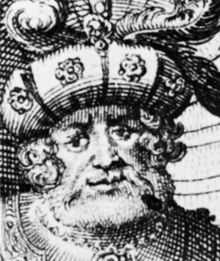 |
Henry II the Proud | 4 December 1137 – 20 October 1139 | Also Duke of Bavaria as Henry X |
Ascanian Dynasty
| Dukes of Saxony | |||
| Ascanian Dynasty | |||
| Image | Name | Date | Notes |
 |
Albert I the Bear | 20 October 1139 – 1142 | Also Margrave of Brandenburg |
Welf Dynasty
| Dukes of Saxony | |||
| Welf Dynasty | |||
| Image | Name | Date | Notes |
 |
Henry III the Lion | 1142–1180 | Also Duke of Bavaria as Henry XII |
With the final removal of the Welfs in 1180, the Duchy of Saxony was sharply reduced in territory. Westphalia fell to the Archbishop of Cologne, while the Duchies of Brunswick and Lüneburg remained with the Welfs. The Ascanian Dukes had their base further east, near the Elbe, resulting in the name Saxony moving towards the east. The post carve-up Saxony is therefore sometimes called the younger Duchy of Saxony. Also the counting of its dukes is discontinued. While the first post carve-up duke is competingly counted as Bernard III—because of two predecessors of the same name before 1180—or as Bernard I with his great-great-great-great grandson Bernard II being counted second. The second post carve-up duke Albert I is already usually counted as the first, although before 1180 he had one predecessor of the same name, being even his grandfather Albert the Bear.
Ascanian or younger Duchy of Saxony
The new dukes replaced the Saxon horse emblem (![]() ) and introduced their Ascanian family colours and emblem (
) and introduced their Ascanian family colours and emblem (![]() ) added by a bendwise crancelin, symbolising the Saxon ducal crown, as new coat-of-arms of Saxony (
) added by a bendwise crancelin, symbolising the Saxon ducal crown, as new coat-of-arms of Saxony (![]() ). The later rulers of the House of Wettin adopted the Ascanian coat-of-arms.
). The later rulers of the House of Wettin adopted the Ascanian coat-of-arms.
| Dukes of Saxony | |||
| Ascanian Dynasty | |||
| Image | Name | Date | Notes |
 |
Bernard I (or III) | 1180–1212 | numberings starting with Ascanian rule or continuing after prior dukes of the same name. Father of the following |
 |
Albert I | 1212–1260 | father of the following two dukes |
| John I | 1260–1282 | joint rule with his brother Albert II until 1282, when John I resigned. Some time after 1272 John I and Albert II divided some competences among each other, however, continued joint rule. | |
 |
Albert II | 1260–1296 | joint rule with his brother until 1282, then fostering John I's minor sons Albert III, Eric I, and John II, who later ascended as co-rulers. In 1296 uncle and nephews partitioned Saxony into the Lauenburg line (Albert III, Eric I, and John II jointly) and the Wittenberg line, where Albert II continued as sole ruler until 1298, then succeeded by his son Rudolf I (see section Dukes of Saxe-Wittenberg below in this arcticle). Uncle of the following three dukes |
| Albert III, | 1282–1296 | joint rule with his uncle Albert II and his brothers Eric I and John II until 1296. In 1296 uncle and brothers partitioned Saxony into the Wittenberg line (Albert II) and the Lauenburg line, where Albert III, Eric I, and John II continued to rule jointly (see section Dukes of Saxe-Lauenburg below in this arcticle). Brother of the following two dukes | |
 |
Eric I, | 1282–1296 | joint rule with his uncle Albert II and his brothers Albert III and John II until 1296. In 1296 uncle and brothers partitioned Saxony into the Wittenberg line (Albert II) and the Lauenburg line, where Albert III, Eric I, and John II continued to rule jointly (see section Dukes of Saxe-Lauenburg below in this article). Brother of the following duke |
| John II, | 1282–1296 | joint rule with his uncle Albert II and his brothers Albert III and Eric I until 1296. In 1296 uncle and brothers partitioned Saxony into the Wittenberg line (Albert II) and the Lauenburg line, where Albert III, Eric I, and John II continued to rule jointly (see section Dukes of Saxe-Lauenburg below in this article) | |
| In 1296 Albert II and his nephews Albert III, Eric I, and John II terminated their joint rule and partitioned Saxony into the Lauenburg line, where Albert III, Eric I, and John II continued to rule jointly until 1303, and the Wittenberg line, where Albert II continued as sole ruler until 1298. | |||
Dukes of Saxe-Lauenburg
Since the Duke of Saxony was considered one of the prince-electors electing a new Holy Roman Emperor, conflict arose between the lines of Lauenburg and Wittenberg over the issue of who should cast Saxony's vote. In 1314 both lines found themselves on different sides in a double election. Eventually, the Dukes of Saxe-Wittenberg succeeded in 1356 after the promulgation of the Golden Bull. To distinguish him from other rulers bearing the title Duke of Saxony, he was commonly called Elector of Saxony.
| Dukes of Saxe-Lauenburg | |||
| Ascanian Dynasty, Lauenburg Line | |||
| Image | Name | Date | Notes |
|---|---|---|---|
| Eric I, John II and Albert III |
1296–1303 | joint rule of the brothers | |
| In 1303 the brothers partitioned the Duchy with Eric I receiving Saxe-Bergedorf, John II Saxe-Mölln and Albert III Saxe-Ratzeburg. | |||
|
|
| |||||||||||||||||||||||||||||||||||||||||||||||||||||||||||||||
|
| ||||||||||||||||||||||||||||||||||||||||||||||||||||||||||||||||||
Dukes of Saxe-Lauenburg (1401–1876)
| Dukes of Saxe-Lauenburg | |||
| Ascanian Dynasty, Lauenburg Younger Line | |||
| Image | Name | Date | Notes |
| Eric V | 1401–1436. | joint rule with his father Eric IV (until 1411), his younger brother John IV (until 1414), and his youngest brother Bernard II (from 1426) | |
| John IV | 1401–1411/1414 | joint rule with his father Eric IV (until 1411) and his elder brother Eric V, brother of the following | |
| Bernard II[1] | 1426–1463 | joint rule with his brother Eric V until 1436. Father of the following duke | |
 |
John V[2] | 1463–1507 | father of the following duke |
 |
Magnus I | 1507–1543 | father of the following duke |
| Francis I[3] | 1543–1571 and again 1573–1581 | joint rule with his son Francis II from 1578. Father of the following three dukes | |
| Magnus II[4] | 1571–1573 | brother of the following two dukes | |
 |
Francis II[5] | 1578–1619 | vice-regent from 1578, administrator from 1581. Joint rule with his brother Maurice between 1581 and 1612. Father of Augustus and Julius Henry |
| Maurice | 1581–1612 | joint rule with his brother Francis II. Uncle of the following two dukes | |
| Augustus[6] | 1619–1656 | brother of the following duke | |
 |
Julius Henry [7] |
1656–1665 | father of the following two dukes |
| Francis Erdmann | 1665–1666 | elder son of Julius Henry and his second wife. | |
 |
Julius Francis [8] |
1666–1689 | younger son of Julius Henry and his third wife. |
| The male line of the Saxe-Lauenburgish Ascanians was extinguished in 1689. The House of Welf usurped the duchy, preventing the succession of the legitimate heiress, Anna Maria Franziska of Saxe-Lauenburg, and resucceeded with its Brunswick and Lunenburg-Celle line. | |||
| Welf Dynasty, Lüneburgish Line | |||
| Image | Name | Date | Notes |
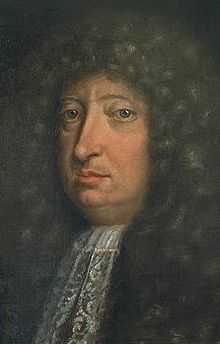 |
George William | 1689–1705 | He invaded Saxe-Lauenburg with his troops, preventing the ascension of the legitimate heiress, Duchess Anna Maria Franziska of Saxe-Lauenburg; this de facto takeover was imperially legitimised only in 1728. He was a great-great-grandson of Magnus I through his great-grandmother Dorothea of Saxe-Lauenburg |
| Welf Dynasty, Hanoverian Line | |||
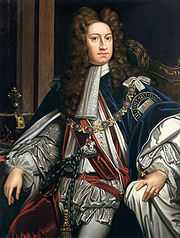 |
George I Louis | 1705–1727 | He was a nephew and son-in-law of George William. |
 |
George II Augustus | 1727–1760 | in 1728 Emperor Charles VI enfeoffed George II Augustus with Saxe-Lauenburg, finally legitimating his grandfather's de facto takeover. |
 |
George III | 1760–1814 | De facto deposed by various occupations in the Napoleonic Wars, he was a grandson of George II Augustus George III's son, Regent George agreed to pass Saxe-Lauenburg to his Danish cousin in a general territorial realignment at the Congress of Vienna |
| Dukes of Saxe-Lauenburg | |||
| Oldenburg Dynasty, Main Line | |||
| Image | Name | Date | Notes |
 |
Frederick I | 1814–1839 | Frederick was a great-grandson of Duke George II Augustus on both sides, through his mother Caroline and through his father. The official colours of Saxe-Lauenburg were changed to red and gold. |
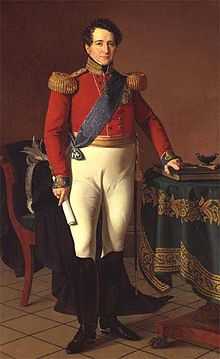 |
Christian I | 1839–1848 | half nephew of the former, but not related to the Saxe-Lauenburgish Welfs, however, great-great-great-great-grandson of Duke Francis I |
 |
Frederick II | 1848–1863 | son of the former |
| Oldenburg Dynasty, Glücksburg Line | |||
 |
Christian II | 1863–1864 | deposed in Second Schleswig War and resigned by Treaty of Vienna. His mother was a cousin of Frederick I and Christian I as well as maternally and paternally a great-granddaughter of George II Augustus. |
| Dukes of Saxe-Lauenburg | |||
| Hohenzollern Dynasty, Berlin Line | |||
| Image | Name | Date | Notes |
 |
William | 1865–1876 | In 1865, the Estates of Saxe-Lauenburg offered him the ducal throne and he accepted. He was a great-great-great-great-grandson of Duke George William. The coat-of-arms of Saxe-Lauenburg was changed to the colours red and silver, with a border in the Prussian colours of black and white. Both duke and estates decided to merge Saxe-Lauenburg into Prussia, as district Duchy of Lauenburg, with effect from 1 July 1876. |
The Ascanian Dynasty continued in Saxe-Lauenburg until 1689, but after the Lauenburgish line had finally lost the Saxon Electorate to the Wittenberg line in 1356 and failed to obtain the succession in the Electorate after 1422, recognition of the Dukes of Saxe-Lauenburg as Dukes of Saxony waned.
Dukes of Saxe-Wittenberg
For the predecessor see the section Ascanian or younger Duchy of Saxony above in this article.
| Dukes of Saxe-Wittenberg | |||
| Ascanian Dynasty | |||
| Image | Name | Date | Notes |
 |
Albert II | 1296–1298 | 1260–1296 joint rule of Saxony with his brother John I, Duke of Saxony (till 1282) and thereafter with the latter's sons Albert III, Eric I, and John II. In 1296 uncle and nephews had partitioned Saxony into the Wittenberg line, where Albert II continued as sole ruler, and the Lauenburg line, where his nephews ruled jointly (see section Dukes of Saxe-Lauenburg above in this article). Father of the following duke |
 |
Rudolph I | 1298–1356 | rivalled as Saxon Prince-Elector by his cousin John II. |
| In January 1356 the Golden Bull confirmed Rudolf I as the legitimate Saxon Prince-Elector, thus the rulers of Saxe-Wittenberg are conceived as Electors of Saxony since (see section Electors of Saxony below in this article). | |||
Wettin Dukes of Saxony
Albertine Dukes of Saxony
The Albertines were a junior branch of the Wettin dynasty of Electors of Saxony (section below), who ruled in Northern Thuringia and Southern Meissen until they replaced the senior "Ernestine" branch as Electors and rulers of most Saxon territory in 1547.
| Dukes of Saxony | |||
| Wettin Dynasty, Albertine Line | |||
| Image | Name | Date | Notes |
 |
Albert the Bold | 1464–1500 | Younger son of Frederick II, Elector of Saxony. Divided the Saxon lands, including Thuringia and Meissen, with his brother Ernest in 1485. |
.jpg) |
George the Bearded | 1500–1539 | Son of Albert. Opposed Martin Luther. |
 |
Henry IV the Pious | 1539–1541 | Brother of George. Introduced Lutheranism to Albertine Saxony. |
 |
Maurice | 1541–1553 | Son of Henry IV. Became Elector 1547. |
Ernestine Dukes of Saxony
Following their displacement by the Albertines, the Ernestine branch of the Wettins continued to rule in southern Thuringia as "Dukes of Saxony", but their lands eventually split up into many different tiny "Ernestine duchies". Of these, Saxe-Weimar-Eisenach, Saxe-Coburg-Gotha, Saxe-Meiningen, and Saxe-Altenburg lasted until 1918. This article does not list the subsequent Ernestine dukes.
Electors of Saxony
The Golden Bull of 1356 confirmed the right to participate in the election of a Holy Roman Emperor to the Duke of Saxony in the Saxe-Wittenberg line. For the predecessor see the section Ascanian Dukes of Saxe-Wittenberg above in this article.
| Electors of Saxony | |||||
| Ascanian Dynasty | |||||
| Image | Name | Began | Ended | Notes | |
 |
Rudolf I | 10 January 1356 | 11 March 1356 | Since 1298 Duke of Saxe-Wittenberg. | |
 |
Rudolf II | 11 March 1356 | 6 December 1370 | Son of Rudolf I. | |
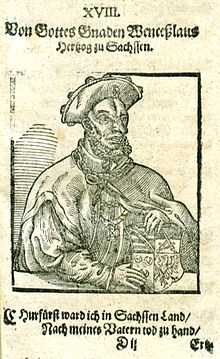 |
Wenceslaus Wenzel |
6 December 1370 | 15 May 1388 | Brother of Rudolf II. | |
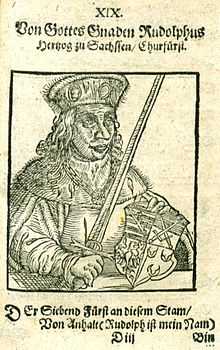 |
Rudolf III | 15 May 1388 | 9 June 1419 | Son of Wenceslaus. | |
 |
Albert III Albrecht II |
9 June 1419 | 12 November 1422 | Brother of Rudolf III. | |
| Wettin Dynasty | |||||
| Image | Name | Began | Ended | Notes | |
 |
Frederick I Friedrich I |
6 January 1423 | 4 January 1428 | Nicknamed "the Warlike." After the Wittenberg line of the Ascanians became extinct, the Electorate was given to Frederick, Margrave of Meissen and Landgrave of Thuringia, of the House of Wettin. | |
 |
Frederick II Friedrich II |
4 January 1428 | 7 September 1464 | Nicknamed "the Gentle". Son of Frederick I. Ruled jointly in Saxony with his brothers, but was the sole holder of the Electorate. Father of Ernest and Albert, founders of the Ernestine (continuing below) and Albertine Saxon lines (see section Albertine Dukes of Saxony above in this article). | |
| Ernestine Line | |||||
 |
Ernest Ernst |
7 September 1464 | 26 August 1486 | Son of Frederick II, divided Saxony with his brother Albert, taking Wittenberg, northern Meissen, and southern Thuringia. Inherited Thuringia in 1482 and ruled it jointly with Albert until 1485. | |
 |
Frederick III Friedrich III |
26 August 1486 | 5 May 1525 | Nicknamed "the Wise." Son of Ernest. Protector of Martin Luther, but a lifelong Catholic. | |
 |
John Johann |
5 May 1525 | 16 August 1532 | Nicknamed "the Steadfast." Brother of Frederick III. Legally established Lutheranism in his territories in 1527. | |
 |
John Frederick I Johann Friedrich I |
16 August 1532 | 19 May 1547 | Nicknamed "the Magnanimous." Son of John the Steadfast. Deprived of his Electorate by Emperor Charles V for his role in the Schmalkaldic War. Died 1554. | |
| Albertine Line | |||||
 |
Maurice Moritz |
4 June 1547 | 11 July 1553 | Second cousin of John Frederick, grandson of Albert. Though a Lutheran, allied with Emperor Charles V against the Schmalkaldic League. Gained the Electorate for the Albertine line in 1547 after Charles V's victory at the Battle of Mühlberg. | |
 |
Augustus I August I |
11 July 1553 | 12 February 1586 | Brother of Maurice. Recognized as Elector by the ousted John Frederick in 1554. | |
 |
Christian I | 12 February 1586 | 25 September 1591 | Son of Augustus I. | |
.jpg) |
Christian II | 25 September 1591 | 23 June 1611 | Son of Christian I. | |
 |
John George I Johann Georg I |
23 June 1611 | 8 October 1656 | Brother of Christian II, ruled during the Thirty Years' War, during which he was at times allied with the Emperor and at times with the King of Sweden. | |
 |
John George II Johann Georg II |
8 October 1656 | 1 September 1680 | Son of John George I. | |
 |
John George III Johann Georg III |
1 September 1680 | 22 September 1691 | Son of John George II. | |
 |
John George IV Johann Georg IV |
22 September 1691 | 27 April 1694 | Son of John George III. | |
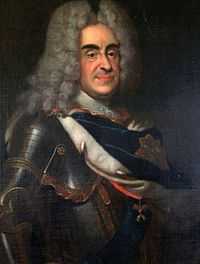 |
Frederick Augustus I Friedrich August I |
27 April 1694 | 1 February 1733 | Brother of John George IV. Converted to Catholicism 1697 in order to compete for the crown of Poland. Took the Polish crown 1697, opposed by Stanisław Leszczyński 1704, forced to renounce the throne 1706, returned as monarch 1709 until his death. Called "the Strong". | |
 |
Frederick Augustus II Friedrich August II |
1 February 1733 | 5 October 1763 | Son of Frederick Augustus I. Converted to Catholicism 1712. King of Poland 1734–1763. Called ""the Fat" or (in Poland) "the Saxon". | |
 |
Frederick Christian Friedrich Christian |
5 October 1763 | 17 December 1763 | Son of Frederick Augustus II, raised Catholic. | |
 |
Frederick Augustus III Friedrich August III |
17 December 1763 | 20 December 1806 | Son of Frederick Christian. His Electorate ceased with the fall of the Holy Roman Empire in 1806, and he became King of Saxony. Called "the Just." | |
| ||||||||||
Kings of Saxony
The Holy Roman Empire came to an end in 1806. The Elector of Saxony, allied to Napoleon I, anticipated its dissolution by becoming the ruler of an independent Kingdom of Saxony in 1806.
| Kings of Saxony | ||||
| Wettin Dynasty | ||||
| Image | Name | Began | Ended | Notes |
 |
Frederick Augustus I Friedrich August I |
20 December 1806 | 5 May 1827 | Duke of Warsaw 1807–1813. Called "the Just." |
 |
Anthony Anton |
5 May 1827 | 6 June 1836 | Brother of Frederick Augustus I. |
 |
Frederick Augustus II Friedrich August II |
6 June 1836 | 9 August 1854 | Nephew of Anthony. |
 |
John Johann |
9 August 1854 | 29 October 1873 | Brother of Frederick Augustus II. |
.jpg) |
Albert Albert |
29 October 1873 | 19 June 1902 | Son of John. Called "the Good" |
 |
George Georg |
19 June 1902 | 15 October 1904 | Brother of Albert. |
 |
Frederick Augustus III Friedrich August III |
15 October 1904 | 13 November 1918 | Son of George. Last king of Saxony. Lost his throne in the German revolutions of 1918. |
References
- ↑ His wife was Adelheid of Pomerania; their daughter, Sophie of Saxe-Lauenburg (before 1428–1473), was married to Gerhard VII, Duke of Jülich-Berg.
- ↑ His wife was Dorothea of Brandenburg (ca. 1446 – March 1519, daughter of Frederick II, Elector of Brandenburg). Their children were Eric of Saxe-Lauenburg (1472 – 20 October 1522; Eric I as Prince-Bishop of Münster, Eric II as Prince-Bishop of Hildesheim) and Sophia of Saxe-Lauenburg (m. ca. 1420, d. 1462; mother of Eric II, Duke of Pomerania).
- ↑ He was married on 8 February 1540 to Sybille of Saxe-Freiberg (Freiberg, 2 May 1515 – 18 July 1592, Buxtehude), daughter of Henry IV of Saxe-Wittenberg. Their children were Henry of Saxe-Lauenburg (Henry II as Prince-Bishop of Osnabrück, Henry III as Prince-Archbishop of Bremen, and Henry IV as Prince-Bishop of Paderborn), Sidonia Katharina of Saxe-Lauenburg (m. Wenceslaus III Adam, Duke of Cieszyn) and Ursula of Saxe-Lauenburg-Ratzeburg (m. Henry III, Duke of Brunswick-Lüneburg [Dannenberg]).
- ↑ His wife was Princess Sophia of Sweden.
- ↑ His wife was Mary of Brunswick and Lunenburg (Wolfenbüttel) (1566–1626; daughter of Julius, Duke of Brunswick and Lunenburg (Wolfenbüttel)); their daughters were Juliane of Saxe-Lauenburg (26 December 1589 – 1 December 1630; m. 1 August 1627 to Frederick, Duke of Schleswig-Holstein-Sønderburg-Norburg) and Sophie Hedwig of Saxe-Lauenburg (24 May 1601 – 1 February 1660; m. 23 May 1624 to Philip, Duke of Schleswig-Holstein-Sonderburg-Glücksburg).
- ↑ His wife, Elisabeth Sophie of Holstein-Gottorp, was the daughter of John Adolf, Duke of Holstein-Gottorp. Their daughter was Anna-Elisabetha of Saxe-Lauenburg (23 August 1624–1688; m. 2 April 1665 to William Christoph, Landgrave of Hesse-Homburg).
- ↑ He was married first to Anne of Ostfriesland, then (on 27 February 1628) to Elisabeth Sophia of Brandenburg (13 July 1589 – 24 December 1629; daughter of John George, Elector of Brandenburg and mother of Duke Francis Erdmann), and finally (on 18 August 1632) to Anna Magdalene, Baroness Popel von Lobkowitz (d. 7 September 1668), who ascended with him to the throne on 18 January 1656. She was mother of Duke Julius Francis.
- ↑ His wife was Hedwig of the Palatinate-Sulzbach (15 April 1650 – 23 November 1681; daughter of Christian Augustus, Count Palatine of Sulzbach); their daughters were Anna Maria Franziska of Saxe-Lauenburg and Sibylle Auguste of Saxe-Lauenburg.
External links
- (German) House Laws of the Kingdom of Saxony